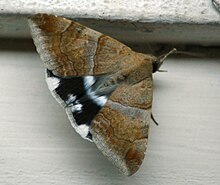| Castor semi-looper | |
|---|---|

| |

| |
| Scientific classification | |
| Domain: | Eukaryota |
| Kingdom: | Animalia |
| Phylum: | Arthropoda |
| Class: | Insecta |
| Order: | Lepidoptera |
| Superfamily: | Noctuoidea |
| Family: | Erebidae |
| Genus: | Achaea |
| Species: | A. janata |
| Binomial name | |
| Achaea janata (Linnaeus, 1758) | |
| Synonyms | |
| |
Achaea janata, the castor semi-looper or croton caterpillar, is an erebid moth, the caterpillars of which are termed 'semi-loopers' due to their mode of locomotion. It is found from the Indo-Australian tropics and subtropics, extending south to New Zealand and east through the Pacific archipelagoes to Easter Island. It is a major pest of castor throughout the world.
Description
Its wingspan is about 60–70 mm. The species has a pale reddish-brown body. Forewings with prominent markings. A short sub-basal waved line and an obliquely waved antemedial and excised postmedial lines are present. Postmedial lines are often black suffused inside them. A speck is found at the end of the cell. A diffuse rufous band runs beyond the postmedial line, Hindwings black with medial white band. Three large white spots can be seen on outer margin, with whitish cilia. Ventral side grey suffused. Forewings with an oblique white postmedial band not reaching the costa. Two crenulate medial lines found on each wing.
Eggs are small, spherical with a greenish color. Pupa is whitish green.
Larva bluish grey speckled with blue black. Head black striped. Lateral and sub-lateral yellowish bands with intervening blue-grey line. A dorsal black stripe bordered by reddish-white spots between fourth and fifth somites. There is a pair of dorsal red tubercles on anal somite. Spiracles and forelegs are red. Four larval instars are completed before pupal stage.
They feed on Excoecaria cochinchinensis (Euphorbiaceae), castor oil plant (Ricinus communis), both Brassica and Ficus species and many more crops like Arachis hypogaea, Citrus, Corchorus, Dalbergia sissoo, Dodonaea viscosa, Euphorbia hirta, Glycine max, Lagenaria siceraria, Punica granatum, Rosa chinensis, Solanum lycopersicum, Tamarindus indica, Theobroma cacao, Vigna mungo and Ziziphus mauritiana.
Attack and control
As they feed off the castor oil plant they may be extremely poisonous and should be avoided at all costs. Caterpillars damage foliage, resulting in defoliation and reduction of photosynthesis process. They also attack stems and bore into them, and finally the whole plant wilts and dies.
Efforts to control the species are mainly mechanical, biological and chemical methods. Hand picking of late instars and usage of pheromone traps and light traps are effective in removing adults. Many parasitoids are used in biological control. Eggs can be destroyed using Trichogramma evanescens. Microplitis maculipennis is effective against caterpillars. Chalcid species Euplectrus and another a braconid, Rhogas are also used. In chemical control, quinalphos, chlorpyrifos, carbaryl, monocrotophos, endosulphan sprays are used. Neem seed kernel extract sprays are used to destroy eggs.
Gallery
-
 Caterpillars, lateral view
Caterpillars, lateral view
-
 Caterpillar, head and dorsal view
Caterpillar, head and dorsal view
-
 Caterpillar on Phyllanthus marianus, lateral view
Caterpillar on Phyllanthus marianus, lateral view
-
 Male, ventral view
Male, ventral view
-
 Male, dorsal view
Male, dorsal view
-
 Female, ventral view
Female, ventral view
-
 Female, dorsal view
Female, dorsal view
References
- Wise, K. A. J. (1954). "Two Cases of Synonymy in the Nomenclature of Lepidoptera". New Zealand Entomologist. 1 (4): 31–32. doi:10.1080/00779962.1954.9722735. ISSN 0077-9962.
- "Croton caterpillar". Crop Knowledge Master. Retrieved 12 August 2016.
- ^ "Acanthodelta janata (Linnaeus)". ICAR-National Bureau of Agricultural Insect Resources. Retrieved 12 August 2016.
- Hampson, G. F. (1894). The Fauna of British India, Including Ceylon and Burma: Moths Volume II. Vol. Moths – Vol. II. Taylor and Francis – via Biodiversity Heritage Library.
- "Castor Oil Semi-Looper moth (Achaea janata)". Australian Wildlife. Retrieved 12 August 2016.
- "Castor semilooper (Achaea janata)". Plantwise Technical Factsheet. Retrieved 12 August 2016.
- Leong, T. M., 2010. Final instar caterpillar and metamorphosis of Achaea janata (Linnaeus, 1758) in Singapore (Lepidoptera: Erebidae: Erebinae). Nature in Singapore, 3: 297–30 Archived January 3, 2015, at the Wayback Machine
- Ronald F.L. Mau & Jayma L. Martin Kessing. "Achaea janata (Linnaeus)". Honolulu, Hawaii: Department of Entomology. Retrieved December 24, 2013.
- ^ "Important Pests of Castor and its Management". Pests of Castor. Retrieved 12 August 2016.
External links
- Species info
- Life cycle of castor semilooper [Achaea janata Linn.] and its control
- Differential oxidative stress responses in castor semilooper, Achaea janata
- Induction of glutathione S-transferase in the castor semilooper, Achaea janata (Lepidoptera, Noctuidae) following fenitrothion treatment
- Calling behaviour and male response to pheromone gland extracts of castor semilooper, Achaea janata
| Taxon identifiers | |
|---|---|
| Achaea janata | |